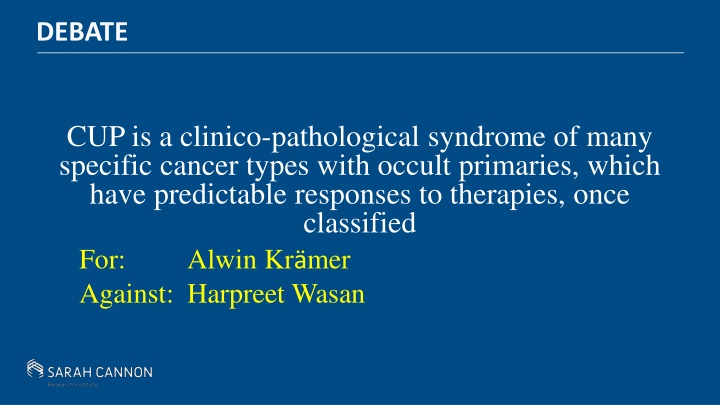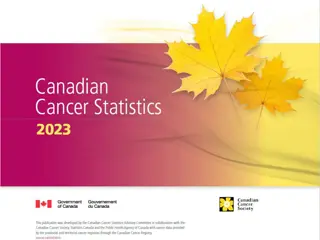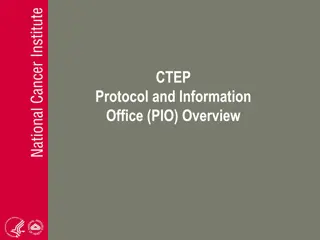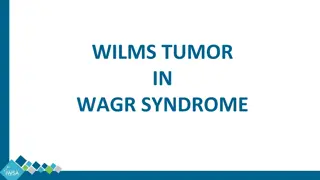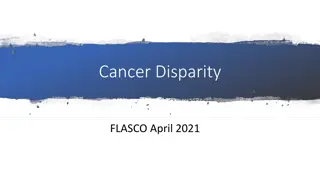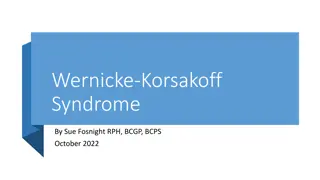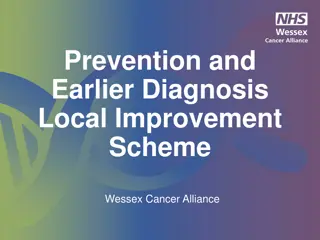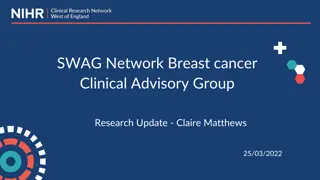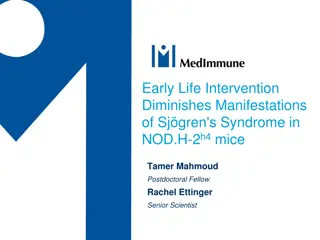Clinical Insights and Debates on Cancer of Unknown Primary Syndrome
DEBATECUP is a clinico-pathological syndrome encompassing various cancer types with occult primaries, each exhibiting predictable responses to therapies once classified. Current evidence supports CUP as a collection of specific cancer types with occult primary sites, posing challenges in primary site identification despite autopsy data showing small anatomical sites. Latent primaries emerging in CUP patients post-diagnosis highlight the complexity of determining primary sites. Favorable subsets within CUP respond similarly to therapies as patients with known primaries. The relationship between CUP and colorectal cancer is explored in relevance to clinical trials like the CRYSTAL Trial.
Download Presentation

Please find below an Image/Link to download the presentation.
The content on the website is provided AS IS for your information and personal use only. It may not be sold, licensed, or shared on other websites without obtaining consent from the author.If you encounter any issues during the download, it is possible that the publisher has removed the file from their server.
You are allowed to download the files provided on this website for personal or commercial use, subject to the condition that they are used lawfully. All files are the property of their respective owners.
The content on the website is provided AS IS for your information and personal use only. It may not be sold, licensed, or shared on other websites without obtaining consent from the author.
E N D
Presentation Transcript
DEBATE CUP is a clinico-pathological syndrome of many specific cancer types with occult primaries, which have predictable responses to therapies, once classified For: Alwin Kr mer Against: Harpreet Wasan
Current framework Supports CUP is Made up of Many Specific Cancer Types with Occult -very small clinically undetectable or less likely regressed primary site with Clinical Behavior of the Specific Cancer Type .is there level one evidence for this ? Or just a practical and philosophical approach to patients and their cancer teams
AUTOPSY DATA - CUP In over 800 autopsies, 75% had small anatomical primary sites identified (often < 1.5 cm, many < 1 cm invasive cancers. Autopsy has limitations in finding very small primaries in breast, liver, intestinal tract, urinary tract, others. Thus the % of anatomical primary sites is likely > 75% .if the primary is small and there is a lot of disease which is the primary and which are metastases?
LATENT PRIMARIES EMERGE About 5-10% of CUP Patients Later (> 3 months) Have Their Anatomical Primary Sites Emerge and were Not Identified at Initial Diagnosis Latent Anatomical Site Identification Provides Direct Evidence of an Occult Primary Site at Initial Diagnosis and Likely also Present in CUP Patients Who Never Have a Primary Site Emerge .MUO Vs CUP why our our classifiers not flagging these events?
CUP FAVORABLE SUBSETS (20% OF CUP) Most Favorable Subsets of Patients with Presumed Primary Sites Have Metastatic Patterns and Respond to the Same Therapies and Have the Same Outcomes as Similar Patients with KNOWN PRIMARY Head and Neck Squamous Cell CA Neck CUP Peritoneal Serous Adenocarcinoma CUP Axillary Adenocarcinoma Women CUP Melanoma Presented as CUP Germ Cell Carcinomas CUP Colorectal IHC or Molecular Profile - CUP .level 1 evidence?
Where is the CUP-CRC like patient on the curve ? CRYSTAL Trial metastatic CRC :OS in ITT Population : CRYSTAL: Kaplan Meier Survival Curves - ITT population ----------------------------------- DRAFT ------------------------------------------ where would a MUO ~ CRC fit? Folfiri (n=599) Cet+FIRI (n=599) 1.0 CRYSTAL: Kaplan Meier Survival Curves - ITT population ----------------------------------- DRAFT ------------------------------------------ No. of Events Median OS [95% CI] 30% of the population are not surviving beyond a year! ?? CUP- CRC Overlap 502 18.6 [16.7-19.8] 487 19.9 [18.5-21.3] Folfiri (n=599) 0.9 Cet+FIRI (n=599) 0.8 HR (95%): 0.88 [ 0.77- 1.00] p-Value: 0.04 (log-rank) No. of Events Median OS [95% CI] For a common cancer this represents a significant population burden -in good ( wished ) or bad part (++) of curve (or both) 1.0 0.7 502 18.6 [16.7-19.8] 487 19.9 [18.5-21.3] Kaplan-Meier Estimate 0.9 0.6 0.8 HR (95%): 0.88 [ 0.77- 1.00] p-Value: 0.04 (log-rank) 0.5 0.7 0.4 Kaplan-Meier Estimate 0.6 0.3 0.5 0.2 Are these subsets not really Conventional Response colorectal 0.4 0.1 Folfiri Cetuximab+Folfiri 0.3 0.0 0 6 12 18 24 30 36 42 48 54 60 0.2 Overall Survival Time (months) cancer ?? At Risk 0.1 Folfiri Cetuximab+Folfiri Folfiri Cet+FIRI 599 599 534 520 0.0 414 427 283 319 197 220 138 160 97 125 67 97 20 33 3 6 0 0 0 6 12 18 24 30 36 42 48 54 60 Overall Survival Time (months) At Risk T:\Drugs\Erbitux\EMR_062202\Studies\013\Tasks\ECCO_2009\Output\graphs\CRYSTAL_013_ECCO09__OS_ITT.emf --- Schlichting, 04SEP09 197 138 97 220 160 125 Folfiri Cet+FIRI 599 599 534 520 414 427 283 319 67 97 20 33 3 6 0 0 T:\Drugs\Erbitux\EMR_062202\Studies\013\Tasks\ECCO_2009\Output\graphs\CRYSTAL_013_ECCO09__OS_ITT.emf --- Schlichting, 04SEP09
EVOLVING DATA RESPONSE TO SITE-SPECIFIC THERAPY IN CUP AND IMPROVED / SIMILAR OUTCOMES Colorectal CUP CK7-, CK20+, CDX2+ or molecular DX Renal CUP RCC, PAX 8, Others or molecular Dx Germ Cell CUP PLAP, OCT4, others, or molecular DX Melanoma CUP S100+, Melan A+, HMB45+ or Molecular Dx Lung CUP CK7+, CK20-, TTF-1+ or molecular Dx Neuroendocrine tumors CD56+, Synaptophysin, Chromogranin or Molecular Dx Others (Hepatocellular, Thyroid, Ovary, Breast) .level 1 evidence? CDX-ve colorectal cancers will never be detected as CRC ..
SITE SPECIFIC THERAPY IN CUP Improves Outcome for Many Cancer Types Compared to Historical Standards Retrospective Studies (Hainsworth et al, Greco et al, Varadhachary et al) Colorectal CUP Diagnosed by Molecular Assay (74 Patients) or IHC (74 Patients) 3 Studies (148 Patients) Response Rates and Survival Similar to Stage IV Colorectal Range 21-37 mo Poorly Differentiated Neoplasms / CUP Diagnosed by Molecular Assay. 25 of 30 Identified Treatable Cancers Including Germ Cell Carcinomas, Neoruendocrine Carcinomas, Lymphomas, and Others Renal Cell CUP Diagnosed by Molecular Assay; Several Confirmed by IHC; Response and Survival like Known Renal CA Treated with Targeted Drugs Epigenetic CUP Assay (EPICUP) Next Slide .level 1 evidence?
EPICUP ASSAY RETROSPECIFIC STUDY (MORAN ET AL. LANCET ONCOLOGY 2016;17:6386 Molecular Assay Based on an Epigenetic DNA Assay Identifies 38 Different Cancer Types 26 Well Characterized CUP Patients Cancer Type / Primary Predicted 188/266 (87%) 33 of 38 (87% Accuracy) Patients Who Later had Latent Primary Found 100% Agreement with IHC Dx in 37 Patients 31 Patients Who Received Chemotherapy Considered Site- Specific/Standard for That Cancer Type was 13.6 mo. Compared to 6 mo for 61 Patients Who Received Empiric Chemotherapy (p=0.0051) .level 1 evidence .31 patients?
LARGE PHASE II PROSPECTIVE STUDY MULTICENTER (HAINSWORTH ET AL. J CLIN ONCOL 2013;31:217) 252 Patients CUP; 247/252 had Single Tissue of Origin Diagnosed by Molecular Assay (Cancer TYPE ID) Median Survival for 194 Patients Who Received Site-Specific Therapies Based on Assay Diagnoses had MS 12.5 mo Compared to 9.1 mo for 396 Historical Control Patients from Same Multicentre Group Median Survival for 115 Patients with Molecular Dx of a Cancer Type Expected to Respond Favorable to Site Specific Rx 13.4 mo versus 7.6 mo in 79 Patients NOT Expected to Respond Favorable Phase III GEFFCAP104 Study Completed Results Pending Japanese Phase II Study confounding Dr. Kramar Discussed
SMALL PHASE II PROSPECTIVE STUDY (YOON ET AL. ANN ONCOL 2016;27:339) 38 Patients had Molecular Assay Specific Diagnosis Empiric Chemotherapy to All Patients Median Survival of 19 Patients with Specific Cancer Types Diagnosed Expected to Respond Favorable to Empiric Rx 17.8 mo Median Survival of 19 Patients with Specific Cancer Types not Expected to Respond Favorable 8.3 mo (p=0.005) .level 1 evidence?
CONCLUSIONS CUP Represents Metastatic Cancers From Many Occult Primary Sites. This is the Unique Common Aspect, yet Unexplained, of All CUP Patients. The Response and Survival to Appropriate Site-Specific Therapies Once the Cancer Type is Diagnosed and Treated as Such is the Same as Metastatic Cancers with Known Anatomical Primary Sites .level 1 evidence? CUP is a clinico-pathological syndrome of many specific cancer types with occult primaries, which have predictable responses to therapies, once classified
